Q. Can a waterproof surface membrane be applied over Stopgap 300 HD?
A. Although it’s most common to apply a waterproof surface membrane over a subfloor before the application of a levelling compound, applying a waterproof surface membrane over a levelling compound can create an effective barrier to stop excess subfloor moisture rising up to the level of floorcoverings and causing floor failure. This may be desirable where the subfloor is particularly rough or uneven, which would cause the waterproof surface membrane to pool. However, instead of Stopgap 300 HD you must select a moisture-tolerant levelling compound. Consider using Stopgap 1200 Pro, Stopgap Green Bag/114 or Stopgap 850 Exterior instead.
Q. What adhesive can I use for installing a vinyl floorcovering in a wet room?
A. The traditional choice of adhesive for installing resilient floorcoverings where they will be exposed to moisture are epoxy or polyurethane-based adhesives. These are effective at creating an impermeable barrier to water. Nowadays, there’s another option. Styccobond F49 Hybrid PS is a new, water-based adhesive that cures to develop the sufficiently high bond strength to hold vinyl floorcoverings firmly in place over a wide range of temperatures and extreme temperature fluctuations. In addition, F49 is water resistant and has pressure sensitive characteristics, making it ideal for installing vinyl floorcoverings in wet rooms.
Q. A concrete subfloor in a cold room requires a wearing surface. What can we use?
A. You can apply Stopgap 800 Wearcoat at a minimum thickness of 5mm. Make sure the concrete subfloor is suitably smooth and sound, and prime with Stopgap P131 beforehand. It’s also important that the temperature of the subfloor remains above 10°C throughout the application and drying of the levelling compound, so make sure the refrigeration equipment is turned off. Once fully dry, apply Stopgap Seal to create a protective barrier against spillages of water and other fluids.
Q. How should I prepare a calcium sulphate/anhydrite screed?
A. If the screed was newly installed, you would need to allow sufficient time for an anhydrite screed to dry before proceeding to prepare it for the installation of floorcoverings. Prime the subfloor using Stopgap P121 – F. Ball’s primer for calcium sulphate screeds. Then you can use a calcium sulphate-based levelling compound, such as F. Ball’s Stopgap 1100 Gypsum to create a perfectly smooth base ready for the receipt of new floorcoverings.
Q. I’m using an F. Ball digital hygrometer to check if a subfloor is dry enough to proceed with installing floorcoverings. What units does it measure in?
A digital hygrometer measures levels of subfloor relative humidity (RH) levels as a percentage. If a moisture test indicates that subfloor moisture levels are higher than 75% RH (65% RH where wood floorcoverings will be installed), the application of a waterproof surface membrane will be required to prevent excess subfloor moisture levels rising up to the level of floocoverings and potentially causing complete floor failure.
Q. I’m looking for a flexible smoothing underlayment to use over a basement subfloor covered with bitumen paint.
A. Stopgap 1200 Pro is suitable for use over old adhesive residues, with no need to prime before applying. Just make sure that the paint is sound and well-bonded to the subfloor.
Q. What’s the best way to apply Styccobond F46?
A. Styccobond F46, F. Ball’s pressure sensitive acrylic adhesive, is best applied using a 1.5mm x 5mm v-notched trowel. Spread the adhesive evenly over the subfloor using the trowel, held at a 60° angle. Styccobond F46 is specially formulated to minimise the appearance of trowel serrations showing through thin vinyl floorcoverings. This can be aided by rolling with a paint roller, pre-coated with adhesive, to flatten the ridges formed in the adhesive by the notches in the trowel.
Q. I’m looking for an alternative to using a contact adhesive for installing capping and coving.
A. Styccobond F49 Hybrid PS, F. Ball’s temperature tolerant, pressure sensitive vinyl adhesive can also be used for installing vertical flooring accessories, such as skirting, capping and coving. The adhesive offers the high initial grab associated with contact adhesives to hold flooring products firmly in place, whether on horizontal or vertical surfaces. Unlike contact adhesives, Styccobond F49 only needs to be applied to one surface to achieve a good bond and allows accessories to be repositioned in the early stages of drying.
There’s also another option now. The newly-launched, reformulated version of F. Ball’s highly-versatile, rapid-curing, flexible tube adhesive, Stycco Flex, has also been approved for installing PVC flooring accessories as a result of improved plasticiser resistance.
The solvent-free nature of both Stycco Flex and Styccobond F49 mean they can be used as an alternative to contact adhesives in biologically sensitive areas, such as hospitals and schools.
Our technical team are on standby to answer questions about your projects and F. Ball products from 7.30am – 5.00pm, Monday to Friday.
Site conditions vary. Don’t rely on these specific responses for your own project. If you are unsure about any technical issue relating to specific flooring installations, contact the F. Ball Technical Service team on 01538 361633 or consult the product data sheets available from F. Ball’s website.


